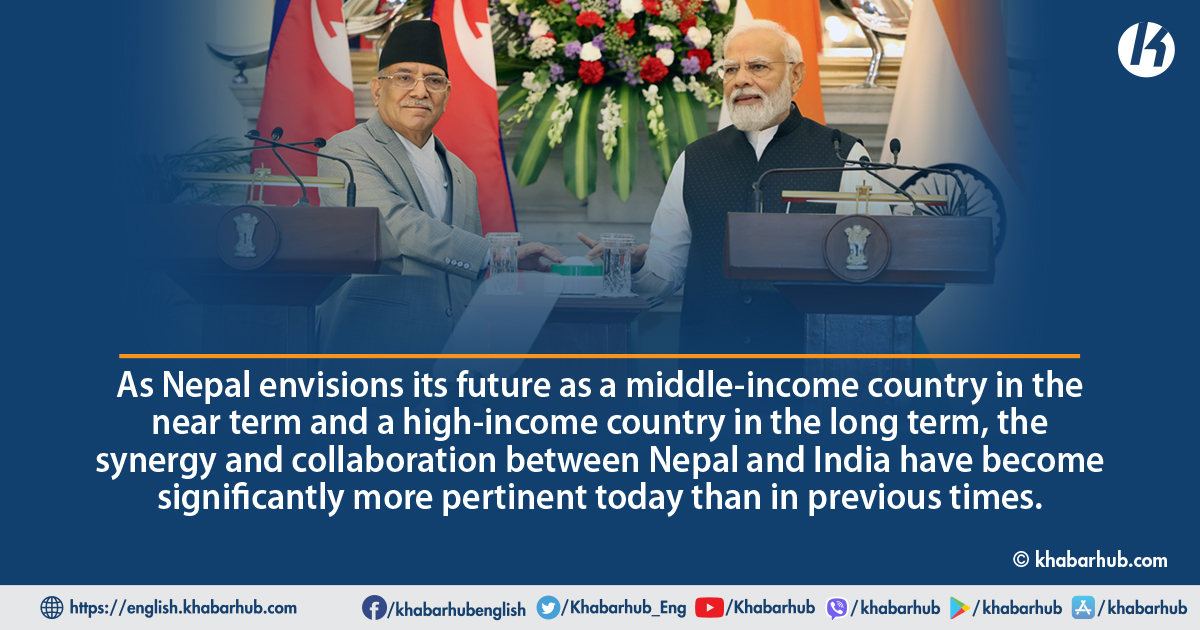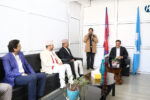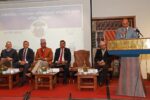The visit of Prime Minister of Nepal, Pushpa Kamal Dahal Prachanda to India holds significant importance as it seeks to take the bilateral ties to a new height, foster greater cooperation, and address key issues of mutual interest.
Given the long and time-tested relationship of Nepal with India and according to an established tradition that continues from the past, PM Dahal chose to visit India first as Nepal’s new government assumed power.
He quipped, “There is a tradition to do so, as we have an open border and our relations have become unique due to economic, political, social and cultural proximity and people-to-people links.”
Notwithstanding some contentious issues between the two countries, which is natural in such close and long ties, Nepali leaders and people find India as a home away from home.
This is because the affinity between the two countries is far beyond diplomatic treaties, financial assistance and mere business relations.
The two countries are bound by shared history and culture besides geographically being the most proximate neighboring countries which matter too much to each other.
The construction of 50,000 houses has been completed, US $ 50 million grant has been allocated for the reconstruction of 71 educational institutes in 8 districts of Nepal.
Despite using India bashing as a tool for political benefits by a few leaders in Nepal, the bonhomie between the two countries remains deeply entrenched and anchored in trust and faith.
The journey of cooperation between the two countries that began with the construction of Gochar Airport in 1951 has evolved and developed into a sophisticated Tribhuvan International Airport today, expanded continually to build part of Mahendra Rajmarga, Tribhuvan University, Kathmandu water supply project, National Archives Building, airports at Janakpur, Bhairawa and Biratnagar, construction of Forestry institute in Hetauda, etc.
The continued saga of cooperation between the two countries has shown that the relationship between the two neighbors could withstand any stress or tension arising temporarily.
The relationship has moved forward despite occasional irritants. India believes since the very beginning of its ties that a prosperous Nepal is in its own interest.
It is because of this that since the beginning of the first Five-Year Plan in 1956 and later in the second and subsequent plans of Nepal India has supported Nepal’s development journey.
During the last seven decades of economic cooperation between Nepal and India, there is virtually no important sector in which India did not support Nepal — be it the development of roads, railways, airports, education, health, or power.
The most recent example of this is India’s inauguration of the Jaynagar-Kurta Section of Jaynagar – Bardibas rail link, the first-ever cross-border broad-gauge rail project in Nepal. Besides, Jogbani- Biratnagar Rail link is under construction, while a survey for the Raxaul-Kathmandu Rail link is in progress.
As a mark of deep trust and willingness to enhance cooperation, many other important projects have been implemented with Indian assistance which includes Hulaki /Terai Road, East–West Fibre Optics, Integrated Check-Posts at Birgunj, Biratnagar, Nepalgunj and Bhairawa (under process).
Motihari-Amlekhgunj Petroleum Pipeline, the first cross-border petroleum product pipeline in the South Asia region.
The pipeline has resulted in direct economic benefits to Nepali people (decrease of NRs. 2/ liter in price) and spared the roads from congestion.
The Energy Sector is one of the most important sectors of Nepal’s economy, in which the two countries have a good track record of cooperation.
The cooperation started with Trishuli Hydropower Project and further continued with the Pokhara Hydropower projects, Kataiya Power House and Devighat Hydro-electric project.
In addition, 70 MU of energy is also being supplied to Nepal, free of cost, from the Tanakpur Hydro Electric Project as per provisions of the Mahakali Treaty.
The 900 megawatts capacity Arun-III project will be the largest power project in South Asia.
Some other projects which are on the anvil between the two countries are Pancheshwar Multipurpose Project, Sapta Kosi High Dam Multipurpose Project (3300 MW) and Sun Kosi Storage cum Diversion Scheme, Kamala and Bagmati Multipurpose Projects, Arun – 3 HE Project (900 MW). Both India and Nepal are hopeful that if the two countries pool their expertise and capital, they could together help remove the power shortage in South Asia.
This visit of PM Prachanda has already come out with some very important outcomes as the two countries have already reached an agreement on 69 MW lower Arun with an Indian company.
The cooperation between the two countries in the social sector such as health and education has continuously grown and looked up for further deepening.
While in the Health Sector, Nepal Bharat Maitri Emergency & Trauma Centre with a cost of INR 100 cr at Kathmandu has come up as the first trauma center with AIIMS-like specialized facilities, there are several others including B.P Koirala Institute of Health Science, Dharan, Construction of 5 storey OPD complex of Bir Hospital (INR 100 cr), Kathmandu, are standing evidence of deepening ties between the two countries in health sectors.
During the Covid-19 pandemic, India firmly stood behind the people of Nepal and provided help with medicines, masks, oxygen and Covid vaccines.
As Education is the key to modernization and empowerment, the two countries have also focussed on cooperation in these sectors.
India assisted the northern neighbor to establish Nepal Bharat Maitri Vidyalaya, Pokhara (INR 125 cr), construction of Manmohan Memorial Polytechnic (INR 32 cr), Tri-Chand College development, Projects in Tribhuvan University (establishment of library, Gandhi Bhawan, girls & boys hostel) are some of the major projects bearing the full cost.
To fill the gap in higher education in Nepal, India has offered several scholarships to Nepali students for studying in prestigious Indian institutions like AIIMS, a highly valued institution to study medicine and surgery, Mahatma Gandhi Scholarship Scheme (MGSS), Golden Jubilee Scholarship Scheme, Homi Jahangir Bhabha Scholarship Scheme, General Scholarship Scheme (GSS), SAARC Scholarship Scheme, APS Scholarship Scheme and COMPEX Scholarship to name a few.
Another milestone of cooperation in the education sector is the construction of Nepal Bharat Maitri Polytechnic, Hetauda.
In the times to come, it is most likely that IndiaNepal cooperation in the field of technical education would increase manifold.
The two countries are cooperating in many other social sectors and governance-related projects including the construction of Pashupati Dharamshala at Kathmandu, the development of Patan Industrial Area, Lalitpur, the installation of over 3000 shallow tube wells in Terai region, the construction of Museum Building at Lumbini and construction of Nepal’s National Police Academy (NPA) (at tendered cost of INR 625.94 cr).
There is an unending saga of cooperation between these two countries especially towards the overall development of Nepal.
So far, the Government of India has distributed 940 ambulances and 184 school buses in different parts of Nepal.
Following the devastating earthquake of April 2015, the Government of India committed US$ 1 billion.
US$ 150 million was allocated to the Housing sector to support 50,000 housing beneficiaries in Gorkha and Nuwakot.
The construction of 50,000 houses has been completed, US $ 50 million grant has been allocated for the reconstruction of 71 educational institutes in 8 districts of Nepal.
The two countries have shown resilience in their bonhomie as the ties are very long and deep.
The people of the two countries have a great sense of belonging and ownership of shared heritage and legacy.
As one of the marks of equitable treatment, Nepalese soldiers and officers receive pensions in the same way as their Indian counterparts.
Each year Nepal receives substantial remittance and pension amounts from India.
Of Nepal’s total remittance of $8.8 billion, although the share of the remittance from India through the official channel is only $1.5 billion, the actual remittance from the informal channels is quite substantial.
The Indian government also sets apart separate budgetary provisions for Nepal.
The Indian Union budget for the fiscal year 2023-24 has allocated Rs8.8 billion (IRs5.50 billion) to Nepal which was Rs7.13 billion in 2021-22.
There is an unending saga of cooperation between these two countries especially towards the overall development of Nepal.
The cooperation is likely to soar as present-day India is far more capable than the India of the 20th century.
While Nepal looks at its future as a middle-income country in the short run and a high income country in the long run, the complementarity and cooperation between the two countries are far more relevant today than in the past.









Comment